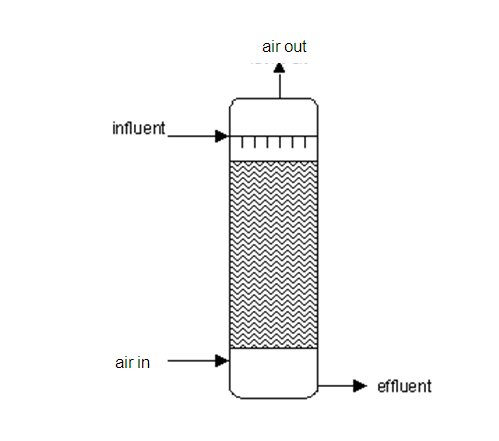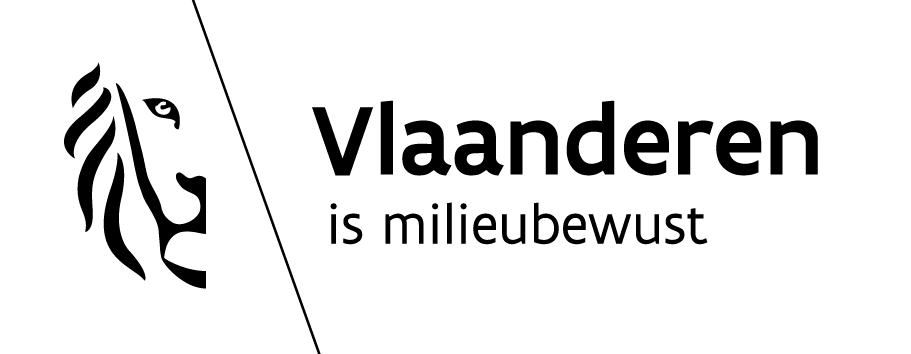Method diagram

Method and installation description
Air stripping is a technique in which wastewater and air are intensively brought in contact with each other. This causes the volatile compounds present in wastewater to be transferred into the air.
The air containing VOC must be treated in an air treatment system (e.g. active carbon installation, bio-filter). A stripper only needs a small surface area; 5x5 m2 is sufficient for a stripper with a capacity of 100 m3/hour. The space taken by an air treatment unit varies greatly.
The main set-up types are the stripping tower or stripping column and the plate stripper. The stripping tower is based on the counter-flow principle, where a vertical column is filled with packing material. The plate stripper is based on the cross-flow principle, where the liquid flow is intensively aerated via a perforated plate.
Specific advantages and disadvantages
The stripping process is cheap and reliable, and provides relatively good substance transfer. One of the disadvantages of this process is that it is susceptible to pollution.
Application
If sufficient attention is paid to pre-purification, stripping is a robust technique that can be easily implemented in a wide variety if sectors and in a wide volume range. Here are a few examples:
- In both inorganic and organic chemistry, stripping is used for the removal of volatile organic substances, sulphur compounds (H2S, phosphine) and NH3. Stripping is normally carried out on the concentrated partial flow;
- Air stripping is used in the pharmaceutical sector for the removal of chlorinated solvents from wastewater;
- In viscose production, air stripping is the standard technique for the removal of CS2 from wastewater;
- In glass engraving with ammonium-based solvents, pH supplementation and air stripping can be used for the removal of nitrogen from wastewater;
- In the graphics sector, stripping is used for the removal of toluene from condensate discharged by recuperation systems;
- In a variety of sectors, air stripping is implemented for the removal of chlorinated solvents from wastewater:
- PER in the dry cleaning sector;
- Methylene chloride in the removal of paint layers from wood.
Air stripping is currently being used for cleaning groundwater in soil remediation, possibly followed by an air-based active carbon filter or bio-filter. The following compounds are primarily removed when stripping groundwater: Aromatic compounds (BTEX) and/or volatile chlorinated hydrocarbons (VOCs, incl. trichloro ethene, perchlore ethene, tetrachloro methane, chloroform).
Boundary conditions
In order to implement the technique, initially the main factor is the ratio between the partial vaporisation of pollution in the gas phase and the concentration of the pollution in the water phase. This ratio is a fixed substance property and is referred to as the Henry coefficient. In fact, this coefficient indicates the stripability" of the compound. The Henry coefficient is determined by the temperature.
Further, a major role is played by the speed of substance transport from the water phase to the air phase. This substance transfer is determined by:
- The interacting surface between the air phase and water phase;
- The retention time in the system or the time that a substance is in contact with the surface (contact time);
- The concentration difference of the substance between the gas phase and the liquid phase (the driving force or the deviation from the thermo-dynamic balance).
The technique is used for volatile compounds that (generally) have a Henry coefficient greater than 0.001 atm.m³/mol. The concentration range in which the technique can be implemented varies from around ten micrograms per litre to a few dozen milligrams per litre.
Iron-removal is needed prior to air stripping for iron contents above 2 mg/l in a stripping column and 5 mg/l in a plate stripper. If iron is not removed, iron deposits could result in blockages which, in time, would require the package to be replaced or cleaned with acid.
The pH must be corrected if the water leaves lime deposits.
The water must be free of suspended matter, in order to prevent blockages. The wastewater must be pre-treated so that all suspended matter is removed (for example, using a sand filter or by using coagulation/flocculation followed by sedimentation).
Effectiveness
Air stripping is primarily implemented for the removal of volatile organic matter (incl. chlorinated hydrocarbons, VOX and BTEX) from wastewater.
If the established condition for the Henry coefficient is met, air stripping can be used to realise high removal yield (e.g. >99% for VOX) per placed unit. If necessary, multiple units can be placed in a series to further increase total performance.
Support aids
Ammoniac can be stripped in an air stripper. If ammoniac is interfering with other pollutants that need to be removed, this can be confirmed using neutralising substances.
Environmental issues
Air containing VOC is released. Air treatment could possibly be needed (e.g. active carbon system, bio-filter). Depending on the influent, the location and the installation, extra measures may be needed to prevent odour and noise problems.
Costs
The costs for implementation of air stripping are determined by the desired purification yield, on the one hand, and the concentration desired in the effluent, on the other hand. These two aspects determine the number of modules (units) than must be placed in the series.
Stripping requires relatively large amounts of energy. Energy consumption with active carbon air purification amounts to circa 0.3 to 0.5 kW/m³ water and to circa 0.1 to 0.2 kW/m³ for a bio-filter.
Comments
Subjecting the wastewater to aerobic biological purification can also result in a stripping effect.
Complexity
Stripping is a relatively simple process.
Level of automation
No data available.
References
- EIPPCB, Reference Document on BAT in Common Waste Water and Waste Gas Treatment / Management Systems in the Chemical Sector, draft February 2009 (revision upon release)
- Environmental Technology, Monographs handbook, Envi Tech Consult, INC, Den Haag, Handbook on Wastewater, 1996.
- RIVM (NL); Technique for processing polluted water released in soil clean-up. Soil cleaning techniques Handbook
http://www.senternovem.nl/Bodemplus/bodemsanering/richtlijn.asp
- VITO-SCT, revision of technical notes WASS, 2008
Version February 2010

